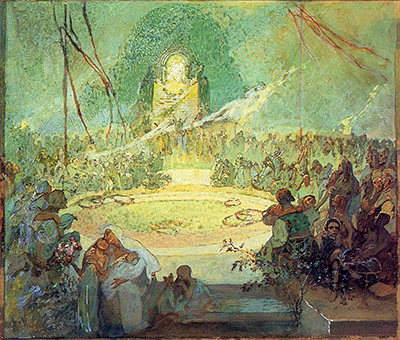This artwork was one of three in a triptych produced by Alphonse Mucha very late in his career. We have discovered the intended format through study drawings that were created using pencil and watercolour.
The Age of Reason, The Age of Wisdom and The Age of Love would be the three titles for the individual pieces of this triptych, which collectively were intended to represent the status of mankind at the time. This project was designed by Mucha in the late 1930s and was likely to have been a reaction to the impending war which could be sensed across Europe at about this time. It would later spread across much of the globe to become the barbaric and shocking WWII. The artist himself had already lived through the earlier world war and would have been very concerned at the prospect of another major conflict arriving. Age of Love was to be the right hand side of this three-piece arrangement, as signified by a number of study drawings which Mucha completed in preparation for this body of work. Sadly, the full selection was not completed in its entirety, but we have plenty available to fully understand what was intended.
The style found within this painting is almost a return to the earlier parts of the artist's career, where he liked to produce allegorical paintings and was yet to arrive at his more famous poster style that would eventually provide him with financial freedom. It may have been that as he approached the end of his career, and life in fact, that Mucha was picking and choosing specific items that he wanted to work in and did not have to concern himself with appeasing patrons. Symbolism would feature many times and in this example it was described directly in the title of each of the three paintings, avoiding any ambiguity for those who studied his work after his death. Most 19th and 20th century artists had careers which were a slow progression over time, but they would rarely then return to older styles later on, seeing this as opposed to development, but Mucha does pretty much that in these examples.
The design of the triptych features wisdom centrally, which implies that it is a necessary bridge between reason and love - almost the combination of head and heart together. The sketches that he produced in preparation were found within a number of different sketchbooks which thankfully kept many related artworks together, greatily helping art historians to document the various stages of his career. Otherwise, smaller items would be harder to link to a specific artwork, such as a quick sketch of a single figure as part of a much more complex design. There is also the added element that this series came right at the end of his career, allowing us to see visually as to how he wanted to work once his reputation and financial future had been entirely secured.




